Hansa Automobil Gesellschaft
The German Motor Industry between World War 1 and World War 2 was a story of mergers, takeovers and reverse takeovers, some of them too convoluted to unravel perfectly. The two major amalgamations were that which formed the Auto Union combine and the one which brought Lloyd, Hansa, Goliath and Borgward under one management.
Hansa started life in 1906 as the Hansa Automobil Gesellschaft, which built small cars powered by a single-cylinder De Dion engine under the name of HAG - taken from the initials of the company name.
The Hansa concern gradually expanded and was soon abandoning the use of proprietary engines in favour of its own four-cylinder unit for the 6/14PS model. Over the years up to World War 1, Hansa improved its products and began to build bigger cars, powered by 2.5 and 3.8-litre overhead-valve engines and fitted with a variety of bodies.
The 2.5-litre type F had about 32 bhp at its disposal in 1911, and was generally clothed in good looking (for the era) coachwork. It was sometimes known as the Alpine, after the Alpine Trial. The 3.8-litre E model had 55 bhp, which was capable of pushing the large limousine bodies, usually fitted on these chassis, at around 55 mph.
Westfalia
Running in production alongside the E and F was the type B, a very sporty machine with spartan trim. It was fitted with a 1796cc, overhead-valve, four-cylinder engine giving 20 bhp at 200 rpm; this endowed the light-car with a top speed of around 50 mph. In 1913, Hansa took over the Westfalia works at Bielfield and Westfalia cars were built there for a spell, alongside the Hansa models, until they were dropped from the range in 1914.
Lloyd of Bremen
In 1914 Hansa merged with Lloyd of Bremen, the resultant company being known as the Hansa-Lloyd Werke AG. Lloyd had been founded in 1906 as the Norddeutsche Automobil und Motoren AG in Bremen, a subsidiary of the Lloyd shipping line. Initially they built Krieger electric cars under licence, but in 1908 a petrol-driven car, the 3.7-litre 15/35 model, was introduced. This was a fairly large, sturdy car, but it and subsequent models were not well received by the public and when Hansa and Lloyd merged in 1914, Hansa was the dominant partner.
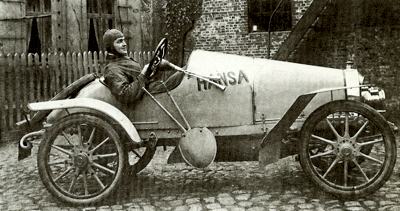 1912 Hansa Sport Type B. It was powered by a 1796cc engine and could achieve over 50 mph.
1912 Hansa Sport Type B. It was powered by a 1796cc engine and could achieve over 50 mph.
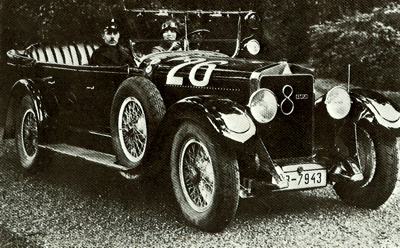 1929 Hansa-Lloyd Tourer, powered by a 5800cc eight cylinder engine, Germany's first.
1929 Hansa-Lloyd Tourer, powered by a 5800cc eight cylinder engine, Germany's first.
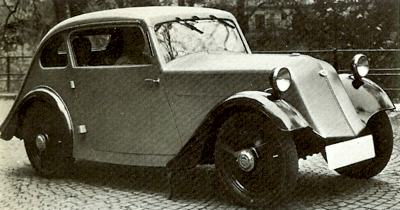 Hansa 500 - the first model produced after the Borgward-Goliath takeover.
Hansa 500 - the first model produced after the Borgward-Goliath takeover.
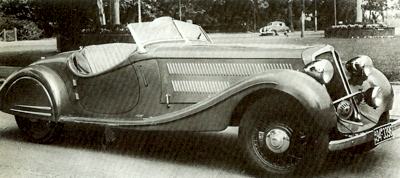 Hansa 1700 Sport, powered by a 1640cc 6 cylinder engine, and produced until 1936.
Hansa 1700 Sport, powered by a 1640cc 6 cylinder engine, and produced until 1936.
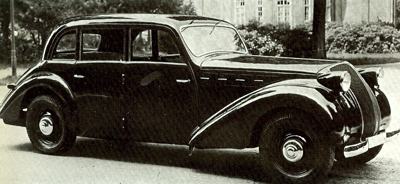 1937 Hansa four-door sedan. It was powered by a 2 litre engine.
1937 Hansa four-door sedan. It was powered by a 2 litre engine. |
The First German Eight-Cylinder Engine
Hansa carried on building its own range of cars, but the new company built Hansa-Lloyds as well. Generally, Hansa-Lloyd concentrated on commercial vehicles, but after World War 1 they built several large and impressive cars. The first was the side-valve, 4-litre H model of 1923, which had 55 bhp at its disposal, butin 1924 the Trumpf As, or Ace of Trumps, appeared.
This had a straight-eight, 4.5-litre, single-overhead-camshaft engine, which was later increased in size to 5.2 litres, at which stage it gave 100 bhp at 3000 rpm. With a silumin block, cast-iron liners, nine main bearings and twin Zenith downdraught carburettors, it was an advanced unit - the first German eight-cylinder engine. The motor was mounted in a large chassis, with a wheelbase of 12 ft 3t in, on which heavy bodies were generally fitted; nevertheless, the 1.5-ton car was capable of 75 mph.
Borgward-Goliath
Carl Friedrich Wilhelm Borgward was a German engineer and designer and the creator of the Borgward group, based in Bremen. He was of modest extraction, the son of a coal retailer, Wilhelm Borgward, and had twelve brothers and sisters. He made mechanical engineering studies, and obtained his engineering diploma in 1913. Injured during World War 1, in 1919 he became one of the partners of Bremer Reifenindustrie. The company was restructured and became in 1920 Bremer Kahlerfabrik Borgward & Co.
Goliath-Werke Borgward & Co.
In 1924 and 1925 the company started to produce the small three-wheel trucks Blitzkarren and Goliath. With his partner Wilhelm Tecklenburg, in 1928 he created the company Goliath-Werke Borgward & Co. The Hansa-Lloyd Trumpf As had not been in production for long when Hansa-Lloyd was taken over by the Borgward-Goliath group in 1929 and manufacture of the luxury Hansa-Lloyds was brought to a complete stop. But Borgward did decide to continue with the Hansa line of trucks.
The Hansa Konsul and Matador
The Hansa Konsul and Hansa Matador were introduced and shortly thereafter the small rear-engined Hansa 400 and 500. In April 1933 the tax rules which were favoring small cars such as the Hansa 400 were abolished. Hansa decided to produce the new Hansa 1100 four-cylinder two door all-steel Sedan, and then the six-cylinder 1700 and 2000. The 2000 carries the Borgward brand.
The name Hansa started to be phased out, becoming Hansa Borgward, then Borgward Hansa and finally Borgward. The Hansas of post-World War 1 years, such as the 13/60 and 16/70, with 3.2-litre six and 3.9-litre eight-cylinder engines respectively, used many proprietary components, including their Continental engines, but they were not good enough to keep the company solvent and the takeover by Borgward-Goliath was an inevitable result.
The Alexander and Arabella
Borgward continued production of Hansa models until 1938, when the cars became Borgwards. The best-known Hansa of this era was the 1100, which became a very popular car. In the Second World War, the factory was completely destroyed - but the Hansa 1100 name reappeared in
1958 on a model in the Goliath range. The Lloyd name also appeared again in
1950, on a small car designed to cash in on the bubble-car boom in Germany.
This twin-cylinder, 293cc car proved quite successful and bigger models, such as the Alexander and Arabella, followed, but were not as popular. The last Lloyd model produced was, in fact, the 897cc Arabella, which was introduced in 1957.
The Lloyd and Hansa names died when the Borgward company went out of business in 1961, although the Arabella was continued in limited numbers until 1963 from stock parts.



